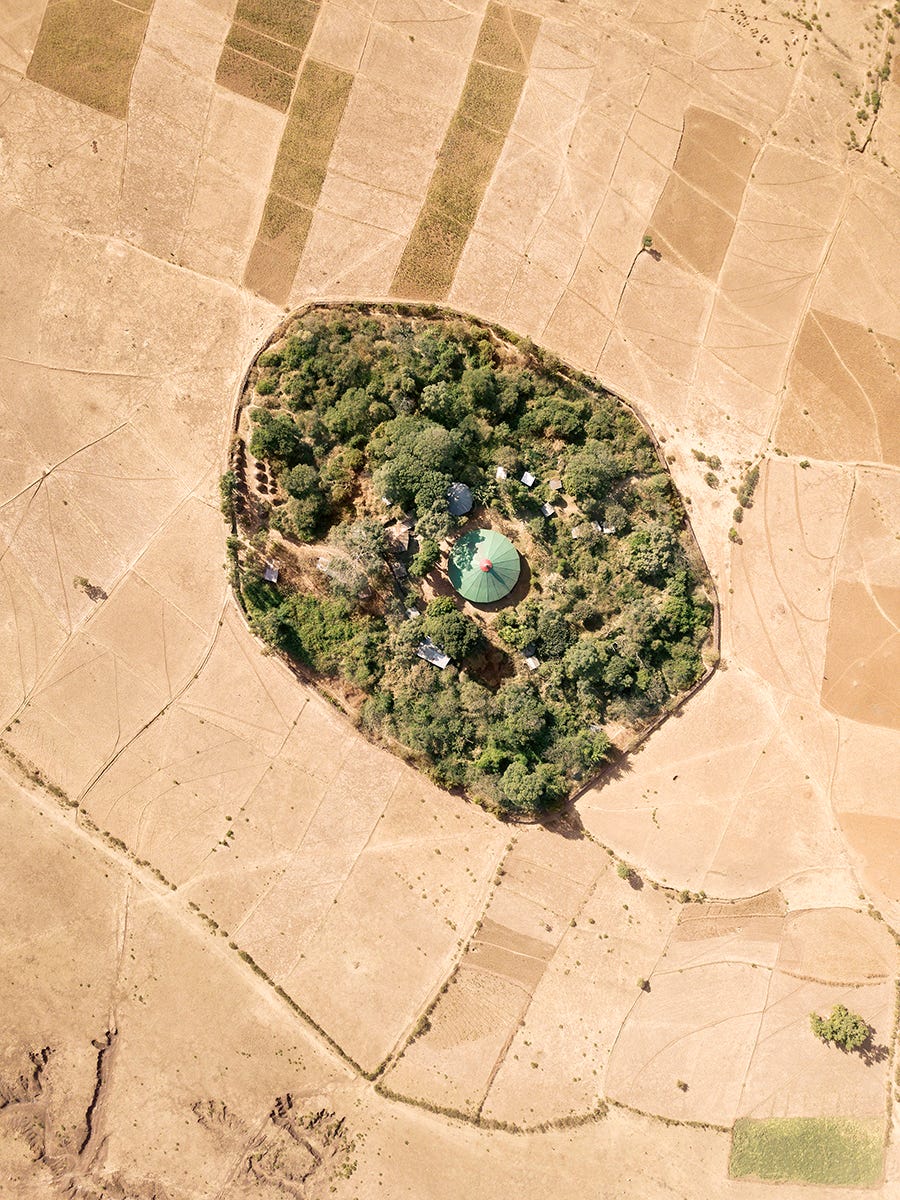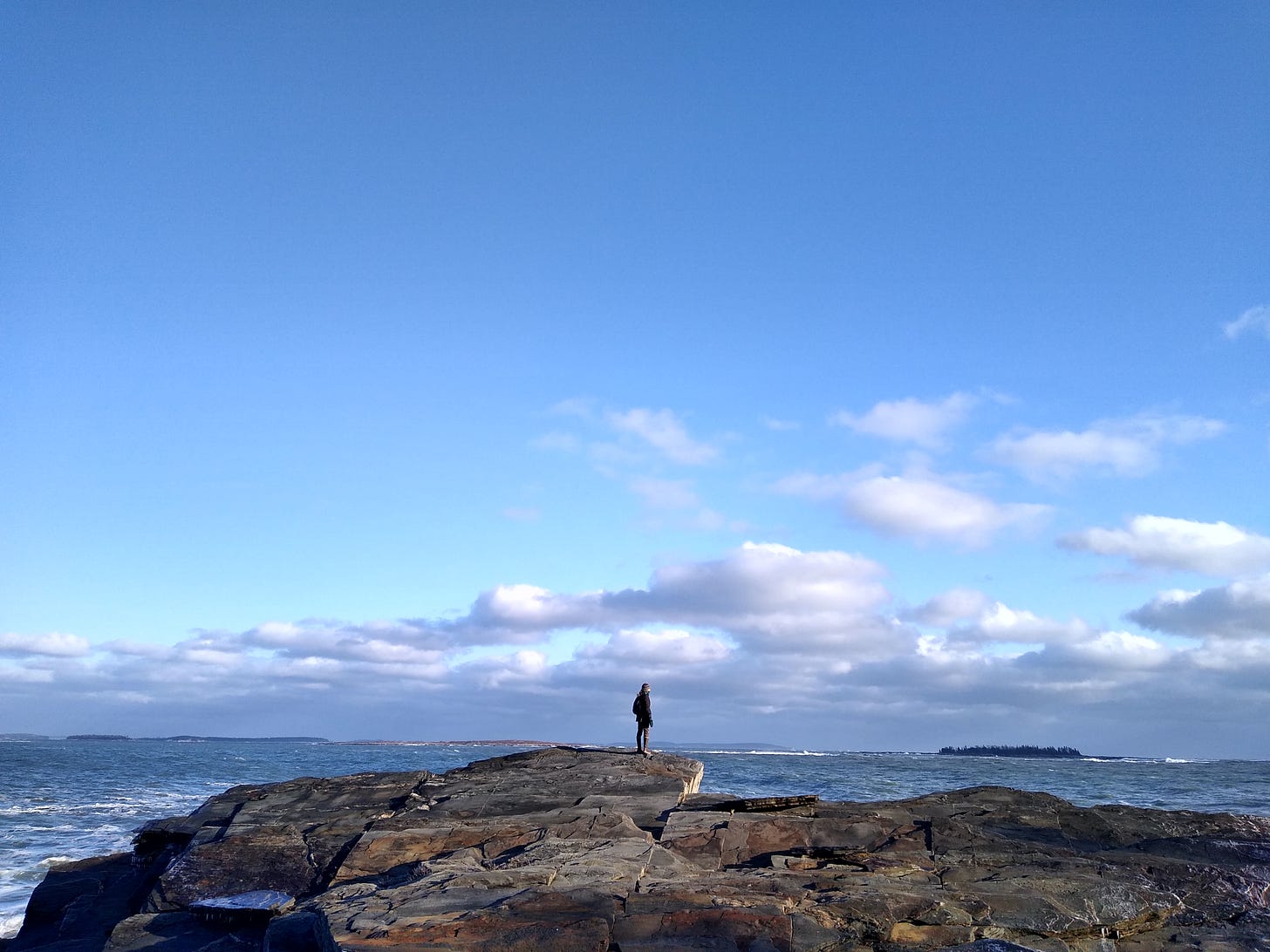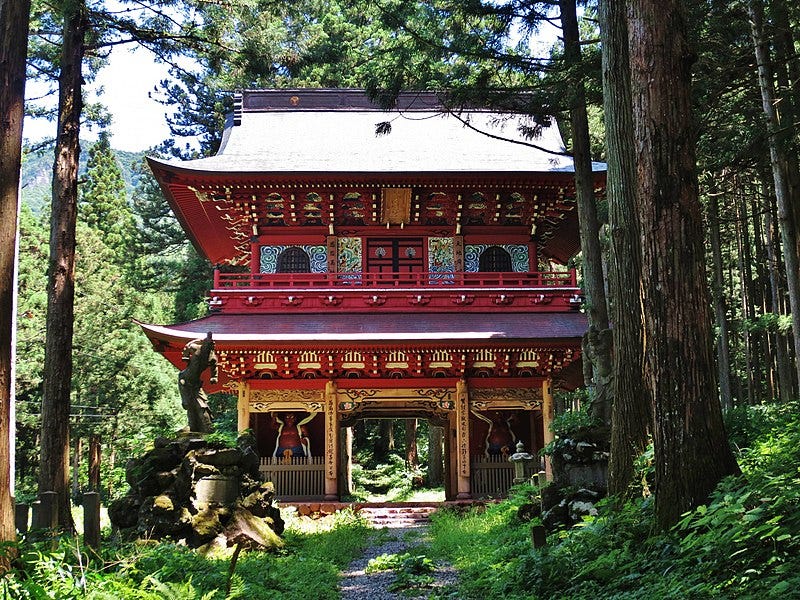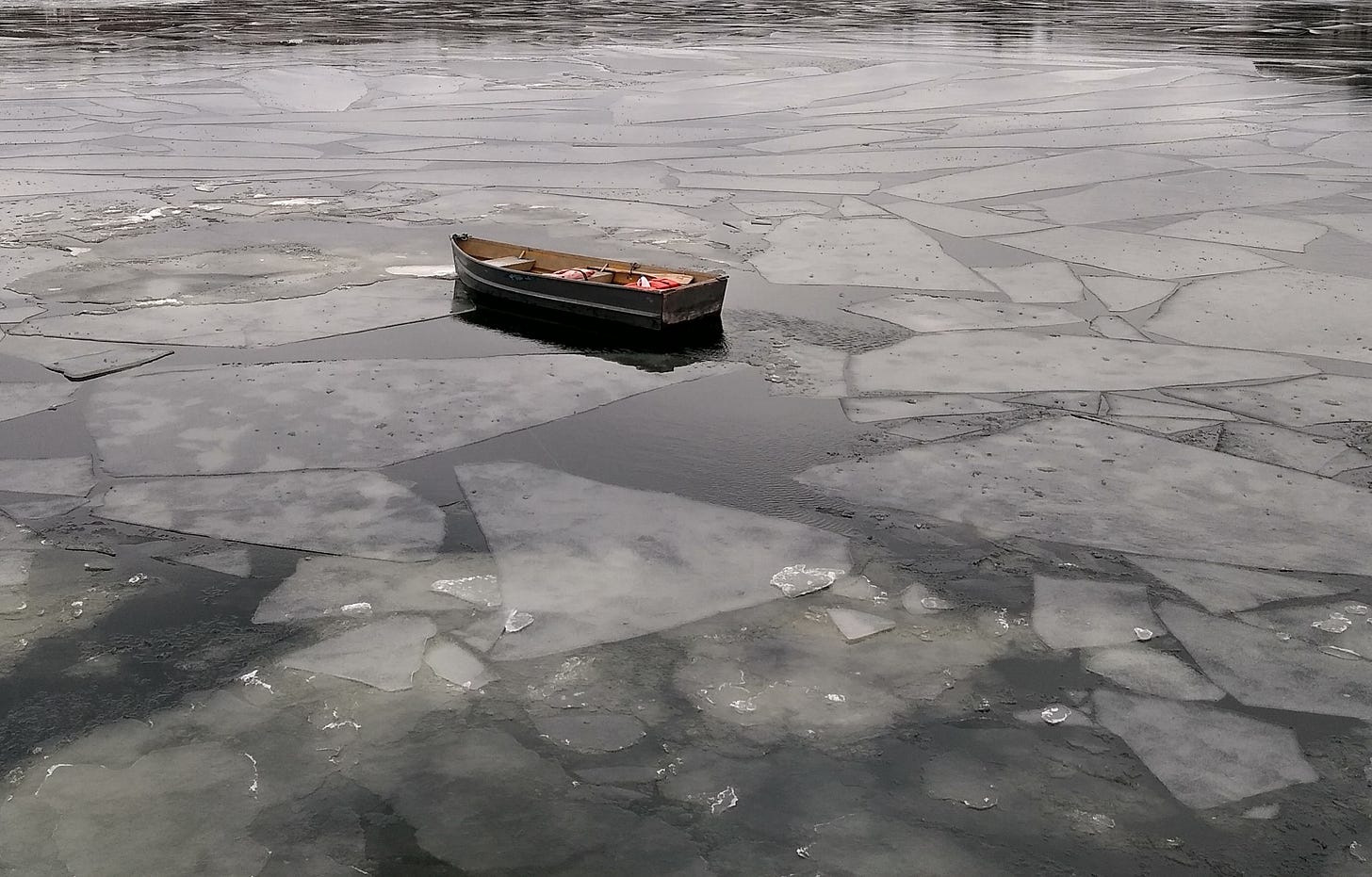Hello everyone:
As always, please remember to scroll past the end of the essay to read some curated Anthropocene news.
Now on to this week’s writing:
Want a simple, one-step solution to the world’s environmental problems? A planetary fix that already has deep roots in human nature and human history? An answer to Earth’s ecological ills that’s already in place in many parts of the world?
There are plenty of days when my one-step answer might be something cynical, as in Send all the humans on that interplanetary journey they seem so keen on taking… But today’s answer is a bit more hopeful, or at least positive.
All we need to do to begin the healing – from habitat loss to overfishing, climatic warming to ocean acidification, from microplastics to nutrient pollution – is to sacralize the world. That is, to make it sacred and treat it as such.
I’m neither religious nor a scientist, but I have enough poetry in me to see that the meeting ground between the physical and the metaphysical is spacious enough to contain all of us. Science is the most extraordinary learning system in human history, but its primary truth is still that we barely understand a thing. We live in mystery. We’re mapping the universe, but we don’t know what it is or what it’s made of. We control, alter, and erase entire ecosystems without knowing what was lost. We’ve studied our bodies intensively for centuries, but a majority of our cells are made up of other species whose relationships with us remain largely unstudied.
Look out your window and take note of what you can and cannot see. Both are beautiful. Our deep knowledge and vast ignorance of reality both demonstrate that the world we share with other strands of life is lovely, astonishing, and worthy beyond all doubt of saving. The fabric of life has been our salvation throughout our species’ history, and now that we’ve diminished the Earth we have little choice but to return the favor. The fate of the world is our fate too.

I started thinking about sacredness as a conservation tool because of another fine article by Fred Pearce at Yale e360. Pearce writes that in some places in the world, sacred sites hold the last remnants of important forests and other ecosystems:
Nobody knows how many sacred natural places there are across the world. They may number in the hundreds of thousands. Almost all societies have them — from Hindu villages in India to Catholic communities in the hills of Italy, and native tribes of the Americas to African animists. The creation and longevity of these places are testament to the power of religion as a tool for community-based conservation. Sacred natural places are “the oldest form of habitat protection in human history,” says Piero Zannini of the University of Bologna, author of a 2021 assessment of their value. “They are becoming ever more important as reservoirs of biodiversity.”
In many places they are the only refuges for endangered species and rare ecosystems. Church forests are now almost the only trees left in the Amhara Province of Ethiopia, holding back advancing deserts. In Japan, there are few if any ancient lowland forests outside the grounds of Shinto temples, which are estimated to cover more than a quarter-million acres.
Like all lush remnants in the Anthropocene, these sacred sites exist in a state of limbo. Are they seeds of future rewilding and reforestation? Or are they merely some of the last gasps of the healthy landscapes that nurtured us? Either way, these fragments are also a map of the fragmentation of our once-common reverence for the natural world.
Over recent millennia, as spirituality more often arose from books rather than from the forests cut to produce them, and as religion became indoor homework rather than outdoor recess, we shed the environmental knowledge and animist faiths that had informed most of human history. In the wake of their loss, we are left with a deep ecological amnesia that explains our distance from, and destruction of, the natural world. We don’t know what we had, we don’t know what we’re losing, and we don’t understand the consequences when it’s gone.
These sacred sites are now refuges for far more than pilgrims. And unsurprisingly, as Pearce notes, these last holdouts are under threat by the human forces – population, consumption, colonialism, capitalism – that have isolated them, continuing to nibble away at all sides. He cites India as one example:
Until recently, there were estimated to be more than 100,000 sacred natural sites across India, though only some 14,000 have been described by researchers. The country’s rapid economic development is taking its toll. “Spiritual beliefs [are] no longer sufficient to ensure their survival,” according to [Indian ecologist Madhav Gadgil]. Yet just as there are no reliable statistics on their numbers, so are there none on their demise.
Pearce cites other losses of sacred sites around the world, but also notes those whose protections remain strong, particularly in parts of Africa. Their persistence doesn’t have a single reason. They may be a well-kept secret or well-funded by tourism. They may benefit from vibrant ancestor-worshipping or animistic faiths, or from a scientific assessment of their rich biodiversity. What all of these factors have in common, though, is a community belief in their importance. The question, then, is to what extent this multitude of community-based conservation efforts can be scaled up.
When I read the article, my first thought was that these places demonstrated the need to create cultural taboos around the destruction of biodiverse regions of the natural world. But in terms of strategy, that’s playing defense in an impossibly unequal conflict. Modern civilization has been built around the idea (a worldview often referred to as human supremacy) that it’s okay to throw all of nature into the industrial blender. So it makes less sense to fight back with a narrow set of taboos than it does to change civilization’s view of the natural world more generally.
Specifically, we need to push a deep, resonant message that an alliance with the natural world is in our best interests, both physical and spiritual. This is not just the usual pragmatic talking point about maintaining a stable climate and healthy forest because it’s good for us too. I’m talking about sacralizing the natural world, which implies a commonsense understanding that life is a beautiful mystery enjoyed by atheists and believers alike.
What paths to sacredness are available? Well, first there are some straightforward practical things to do for the sacred places that still exist. We must ensure their survival regardless of whether they still have faithful populations and institutions to protect them, and expand their borders wherever possible. More broadly, Indigenous peoples must have the rights and funding to protect the life within their lands and waters. Where possible, these lands and waters should be expanded, because still today Indigenous communities are far better at conservation than the rest of us. (This is a topic I intend to explore another day.) And finally, there must be recognition at all levels of governance that these sites and territories are beyond the reach of industrial-scale development not merely because they are protected, but because they have an inherent value beyond human interests.
I like what renowned photographer Amy Vitale says about Indigenous communities in a Guardian article in which she discusses why she shifted her photography work from documenting wars between humans to documenting our war against nature:
I realised the backdrop of every story was the natural world. In some cases, it was the scarcity of basic resources, like water. In others, it was the changing climate and loss of fertile soil. But I started to understand that it’s always the demands placed on our ecosystem that drive conflict and human suffering. Indigenous communities have always understood how important the natural world is for their existence. I believe they hold the keys to saving what’s left of wildlife and nature.
For more recent belief systems, the faithful must be called to the cause of protecting and restoring God’s green Earth. In this effort, no one has done more than Pope Francis with his remarkable encyclical letter Laudato Si’, in which Francis enters “into dialogue with all people about our common home.” The Pope reminds believers and the rest of us that “the earth herself, burdened and laid waste, is among the most abandoned and maltreated of our poor.”
[Our sister, Mother Earth] now cries out to us because of the harm we have inflicted on her by our irresponsible use and abuse of the goods with which God has endowed her. We have come to see ourselves as her lords and masters, entitled to plunder her at will. The violence present in our hearts, wounded by sin, is also reflected in the symptoms of sickness evident in the soil, in the water, in the air and in all forms of life.
It's hard to assess the impact of Laudato Si’ and Francis’ good work to promote it, but some suggest it pushed the Paris climate accords in the right direction and remains a potent force among Catholics. PBS put out a special documentary on it called The Letter: A Message For Our Earth, which I haven’t watched yet. (It’s only available until January 18th, so tune in soon.)
I don’t have the space here to properly explore other large-scale faith-based environmental thinking around the world (like the Faith for Earth initiative at the U.N. Environment Program), but I want to point you toward two people. First, the Times has a good interview with Katherine Hayhoe, an evangelical and climate scientist with the Nature Conservancy. Second, I am particularly impressed with the work of Fazlun Khalid, scholar, activist, author of Signs On the Earth: Islam, Modernity, and the Climate Crisis, and founder of the Islamic Foundation for Ecology and Environmental Sciences. I recommend you explore his ideas in this excellent article from USC’s Center for Religion and Civic Culture. My sense is that Khalid is fighting an uphill battle within his community, but aren’t we all?
Finally, then, there are the rest of us, those who are neither Indigenous nor drawn to religion and its calls to action. What’s the sacralizing message for us? Some of us already heed our own environmental ethics or sense of sacredness, of course, but it’s not enough. The deep wonder so many of us have, whether on a walk or while watching nature documentaries, is not enough. That wonder is not yet creating rational governmental policy nor reining in corporate behavior. How do we broaden that wonder to a societal-scale reverence?
Certainly this isn’t about pretending to be Indigenous. Nor is it about constructing some new animist faith. Instead, we need to instill in ourselves a set of ethics that acknowledges the great and unassailable value of the life all around and within us. The tapestry of plants, animals, and microbes is not merely a resource for people, but neither is it merely a spectacle to be gazed at. It’s our home and we’re still in it, even as we light the flames, drive the machines, and produce the toxins that abuse it.
That’s the elegant answer to making the world sacred, I think. Acknowledging, as a civilization, that the natural world is our home.
Even as I write this, I know it sounds like a bumper sticker. Earth is our only home. But the truth of it is unavoidable. That truth is derived from both our ancient values and our contemporary ecological knowledge. An informed reverence, you might call it.
Our outsized impacts on the planet have given us a god-like status – we determine who lives and who dies – but we need to decline the throne. There is no “environment” separate from us; there is only the world. We’re part of the fabric of life and the fabric must be whole in order for our lives to have a deeper meaning. As Daniel Quinn writes in Ishmael, we need an everyday understanding that the world does not belong to us, and sufficient modesty to recognize that we belong to the world.
This quest for sacredness is about rooting the actions that must be taken to limit the ongoing catastrophes of the Anthropocene within the knowledge that already exists across human cultures: 1) nature is our home, 2) its loss is our loss, 3) science and traditional faith both make it clear that the richer the Earth’s array of life is, the richer our lives will be, and 4) our health, whether physical, mental, or emotional, relies on connection with the real world that nurtured us.
We need an argument now that shifts the dialogue entirely, so that a generation from now, when all hell is breaking loose, there will be only pockets of conservative resistance. Earth is our only home doesn’t rise to that level, but it’s the worldview we need.
There’s hope in seeing how the arguments rooted in science (and self-interest) have finally shifted the dialogue on climate. We’ve moved beyond the extraordinary efforts of the fossil fuel industry to cast doubt on the science. We’re almost at the pockets-of-resistance stage. That’s where we need to be with the biodiversity crisis, but it’s an even tougher case to make. The climate argument has had to overcome the most powerful industry in human history and our reliance upon it, but the fabric-of-life argument must convince us to substantially resize and restructure civilization.
Economies will be reimagined, food and shelter and transport will change, and population will shrink. “Sustainability” is another bumper sticker word, but I’m not sure how many people realize that the true ecological sustainability we need will require both a revelation and a revolution. The worldview of human supremacy is built into who we are and what we do. What we now unthinkingly consider sacred – capitalism, consumerism, constant growth – must become deconsecrated and diminished.
To get to where we need to be, with the natural world brought back into a state of abundance and our broad array of threats to it made harmless, we’ll need to unthinkingly consider the Earth our home and act accordingly. It’s a “one-step solution,” as I offered at the top of this essay, but it’s a big step.
There’s so much I haven’t said here. I’m very curious to hear your thoughts and to continue the conversation in the Comments. Please don’t be shy. For now, though, since Fred Pearce’s article got me started on this week’s writing, I’ll give him the last word. Here are his closing paragraphs:
In the United States, the Menominee people of Wisconsin have practiced a sophisticated system of sustainable logging for more than 150 years in the forest that makes up most of their reservation. The rules are tied to cultural principles and spiritual values derived from the desire to protect the forest habitat of the five animals that feature in the tribe’s creation story and represent its five clans — the wolf, bear, eagle, moose, and crane.
Modern silviculturists and forest ecologists regularly make pilgrimages to the Menominee reservation to find out how they do it. But the answer is at root as much spiritual as technical. Their forests are sacred and treated as such.
Thanks for sticking with me.
In other Anthropocene news:
From Elizabeth Kolbert at the New Yorker, “The Good, the Bad, and the Ugly,” a short summary of three new climate reports.
I’ve been thinking about writing a piece on the harm gas cookstoves cause to both human health and the environment, but instead I’ll point you to “Turn off the gas,” Bill McKibben’s latest issue of The Crucial Years, his Substack newsletter. He cites studies on the problem, but he also lists the charms of the solution: the electric induction stove. His piece is short, sharp, and funny. If you’re at all suspicious about your gas stove – and you should be – check it out. Here’s a deeper dive into induction stoves too.
From Vox, an in-depth explanation and history of why all consumer products are so cheaply made and hard to repair. The article doesn’t focus on the climate and other environmental consequences of bad manufacturing, but those consequences are enormous. What if your bra lasted ten years and your kitchen appliances could be handed down from one generation to the next?
From PBS News Hour, Brazil’s new minister for the environment will be a fierce defender of the Amazon forest and peoples. This is vitally important for the region and the world.
From the Times, readers respond to a question about how 2022 had shaped their thinking on climate change and what they planned to do about it in 2023. One of my favorites is from a resident of New Zealand (one of my favorite places) who said the goal wasn’t some fantasy about returning the Earth to some pre-Anthropocene state, but the more realistic hope of returning “our natural systems to a state of true abundance.”
From the New York Times Magazine, a long-form story that chases a question whose answer will partly define the 21st century and the Anthropocene: Under the stresses of heat, drought, fire, logging, and agriculture, is the Amazon rainforest nearing a tipping point?
From Hakai, a collection of favorite articles from 2022. For those of you new to Hakai, it’s a Canadian magazine publishing excellent, thoughtful pieces focused on the world’s coastlines.







Wendell Berry whispered in my ear as I read your marvelous essay: "There are no unsacred places. There are only sacred places and desecrated places." This is exactly what I've been up to for a while now -- however humbly. Modern humans need a new story -- to return to the one we used to know for millennia -- that we are a tiny part of the vast web of life, not the pinnacle, not the purpose. Simply, always, one of many. Our job is to notice and celebrate.
Though I love the idea of cultivating "societal-scale reverence," I tried that for a couple decades and found that I do better on a less ambitious scale: myself, my family, friends, students, writing, creative projects. I have to trust that the ripples are going out.
"As Daniel Quinn writes in Ishmael, we need an everyday understanding that the world does not belong to us, and sufficient modesty to recognize that we belong to the world." This is such an important call to reverence--that it requires humility. I love that you write about this and are exploring it in depth--it's maddening how the industrial capitalist machine renders lands into resources, how the need for power over runs through all of the individualism and capitalism that we are so steeped in. Grateful to find your work writing about this. 💜